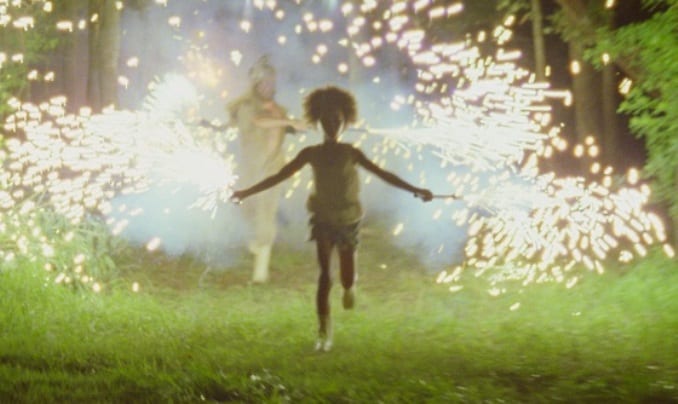Reading Sundance 2012
by hollyherrick on February 15, 2012 in Festival Strategy
The Sundance Film Festival ended two weeks ago, but the conversations it started will be continuing and evolving throughout the year, as this year’s films travel on to the rest of the world. Sundance is always a milestone. It marks chapters in our own lives as we see a new crop of important films for the first time. Our memories of Sundance are earmarks of each new year.
Better than my own scattered memories, for my Sundance diary, I wanted to round up some good writing that might help to establish a lateral picture of this year from many different critical points of view.

The shadow outline of Quvenzhané Wallis on the front page of the arts section of The New York Times was almost a shock to see—BEASTS OF THE SOUTHERN WILD felt too intense, too personally magical, for it to be real that anyone outside of the Eccles at its morning premiere would know that this film even existed. It took me a second to digest that BEASTS was the central title in Manohla Dargis’ Sundance wrap-up, and also in her opinion, “the best film to play at Sundance in two decades.”
Manohla’s take on the film summarizes the visceral glory and excitement of experiencing BEASTS OF THE SOUTHERN WILD for the first time at Sundance. It is so rare that a film seems to be introducing a new language onto the screen, so fresh and inspiring that it leaves most at a loss for description. BEASTS dominated the atmosphere of the festival, leaving little room for the same level of excitement elsewhere.
Similar to Manohla’s Sundance wrap-up, James Rocchi’s brief history of Sundance-past gets at what felt special in 2012. Rocchi documents the ennui of mini-majors in the mid-2000s followed by an ambivalent and uneven climate post-financial crisis, and believes that this is the year that the festival’s relevance in handling the cultural zeitgeist through independent film reasserted itself.
However, for many festival attendees, last year’s festival was the one that seemed like a return to form, when the festival presented many low-budget outside-the-box gems like TAKE SHELTER, THE CATECHISM CATACLYSM, TERRI and THE OREGONIAN. Mike S. Ryan at Hammer To Nail champions the independent spirit of the 2011 lineup to cast a critical eye at this year’s festival, but still found some shining talent in the new independent auteurs of 2012, particularly COMPLIANCE and THE COMEDY (which he produced).

Tom Hall’s reports for Filmmaker are insightful Sundance diaries. His “Sex, Drugs And Falling Apart” alludes to the festival’s external influences: the mountains, the feeling of remoteness and insularity of snow and ice, offer a backdrop for movie watching that can intensify our experiences as movie goers—as Tom says, “the perfect weather for introspection.”
One oft-overlooked element of festival coverage is the mood of the festival environment, so heavily influenced by off-screen factors such as the Saturday blizzard, which effectively stopped traffic and destroyed well-laid plans on what is typically the festival’s busiest day. Also in the air was the fact that some of the most highly buzzed about films were also those dealing with sobering realities: rape in the military (THE INVISIBLE WAR) and rapidly melting glaciers (CHASING ICE). There are always many difficult films in the documentary competitions, but somehow this year the brokenness of our society and culture really burned. Surrounding all this was the independent film industry’s own tragic loss, the untimely death of veteran distributor, Bingham Ray, in the middle of the festival.
I don’t know if it was the overriding solemnity, but this year’s Sundance had a sense of palpable earnestness. I heard more conversations dealing with the films than about budgets and sales numbers. It felt grounding—like the industry was there because they believed in all of this, in spite of everything.
And yet Karina Longworth, who always does bring really worthwhile thoughts to elucidate the big picture of Sundance, noticed a continued upsetting festival trend in a conversation published on Indiewire. Says Karina: “It’s shocking how little debate actually happens about the merits of any individual film at the festival, because too many attendees with a “voice” approach the festival as though it’s a place of right and wrong answers.”
This, to me, is an essential point about major festivals in general: ‘What did you like?’ and ‘What is your favorite?’ are the dominant questions. In our fear not to miss a film, we ask everyone we encounter what they thought of what they just watched. A curious colleague who asks, ‘What did you think?’ usually doesn’t care to stick around to dig in and try to read the film with you. And this atmosphere of heavy consumption defines every Sundance—for many of us, our job is to see as much as possible, and often that means we’re not digesting as well as we should be. Sometimes the less assuming yet very thoughtful film is lost in the mix. (For me, the overlooked victims this year were the weighty and complex THE ATOMIC STATES OF AMERICA and the intensely cinematic FOR ELLEN.)
There was almost too much work to love at this year’s Sundance. I can’t believe how much excellence and artistic ability I experienced at the festival this year, and I missed seeing many films that were highly praised by others. Speaking of earmarks, it will be very difficult for next year’s festival to compete with this year’s anomalous crop of exceptional films.
